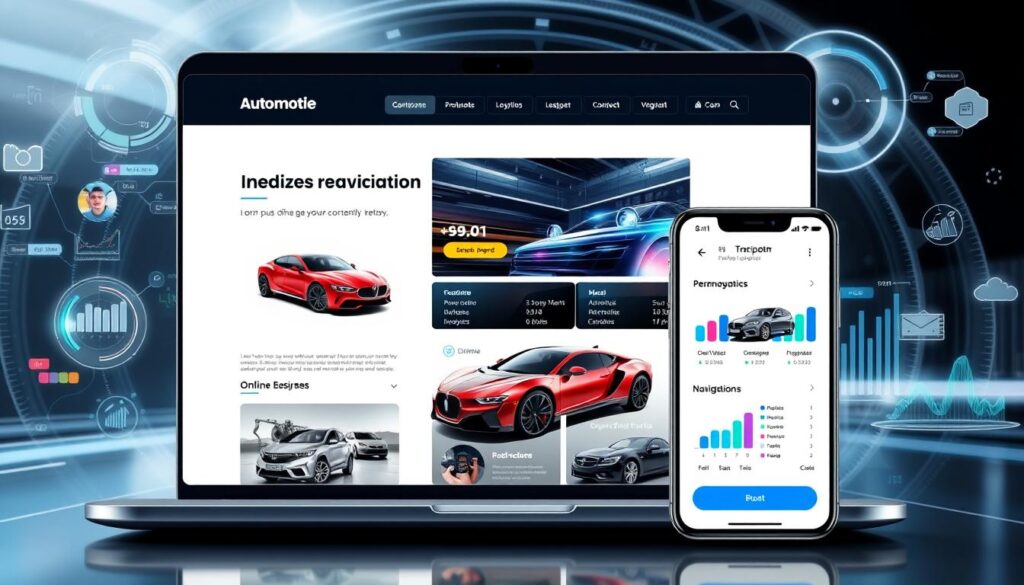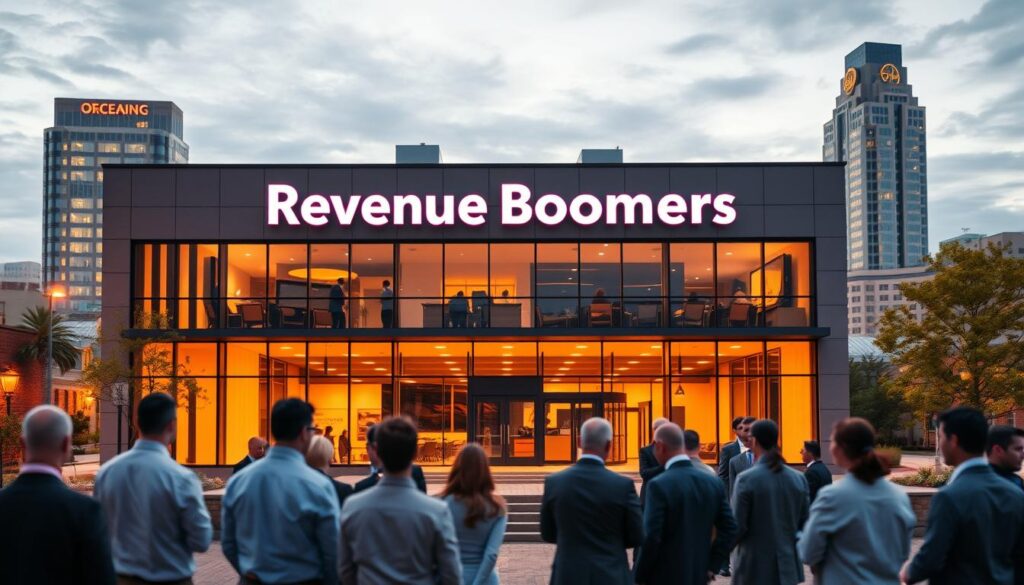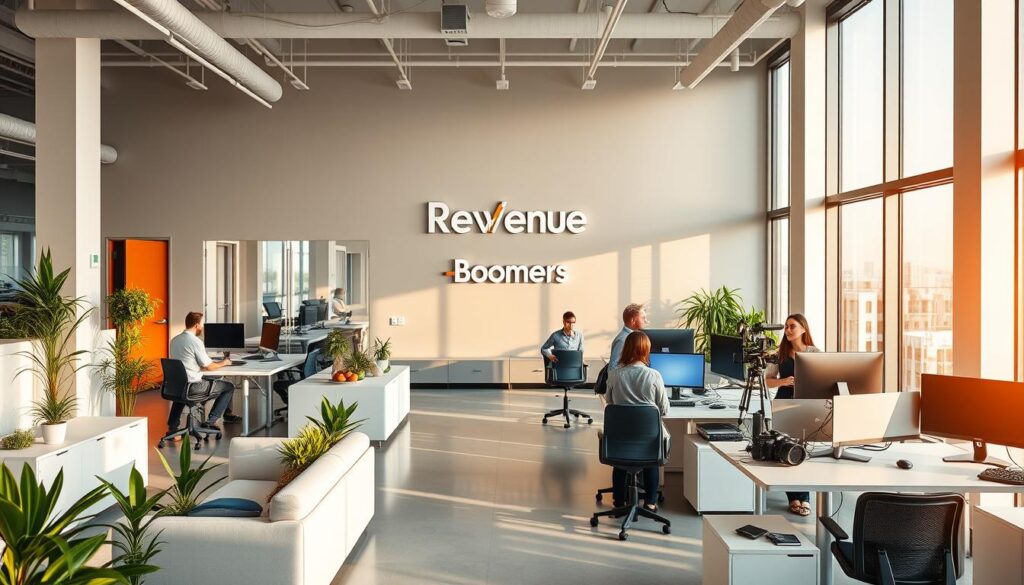Can your car business grow without a solid SEO plan? With about 88% of car buyers using digital tools to find their next vehicle, a good SEO strategy is key. This guide will show you how to boost your website’s visibility, attract more visitors, and increase sales.
The car industry is a high-stakes area, known as YMYL. It needs a focus on expertise, trust, and authority (E-A-T) to succeed. Google’s algorithms change often, so staying ahead is crucial. This guide will help you improve your online presence and beat your rivals in this fast-paced market.
Key Takeaways
- Understanding how the automotive industry fits within the YMYL framework.
- Recognizing the importance of continuous monitoring for effective SEO.
- Implementing E-A-T principles to build trust and authority.
- Utilizing keyword research tools to identify strategic opportunities.
- Emphasizing the role of technical SEO for website optimization.
- Combining organic and paid search strategies for optimal ROI.
Understanding the Automotive SEO Landscape
Getting to know the automotive SEO world is key for success online. Car businesses face a wide range of customers, from car lovers to people just looking for a reliable ride. With so many car types and models, finding the right keywords and content is a big challenge.
Today, more than 88% of potential car buyers look online for info. They spend about 14 hours and 39 minutes researching online. And, 95% of shoppers check social media too. This shows how important good visuals and videos are for car businesses.
Knowing your local market is vital for car businesses. Local search trends and what people like in your area can help shape your content. Most car buyers start their search online, so being visible is crucial. Getting links from trusted sites can also boost your ranking.
Keeping an eye on your website’s traffic and how users interact with it is important. This helps you improve your marketing. Building trust with customers is also key in the car industry. Good digital marketing can help you do that.
What is the SEO strategy for the automotive industry?
An effective SEO strategy for the automotive industry is complex. It focuses on engaging users, improving website tech, and creating high-quality content. Understanding what users want is key. Websites need to match what people search for when looking for cars.
Car buyers often check out 10 different dealership websites. This makes having a strong online presence crucial for getting good leads. Keyword research is vital to find out what people are really looking for in car searches.
By looking at keywords and how competitive they are, dealers can focus their efforts better. Digital ads are on the rise, but traditional ads are not. This means businesses need to invest more in digital marketing.
Keeping content fresh and relevant is important. Search engines like this and can boost your website’s ranking. Using structured data, or schema mark-up, can also help a lot. Websites that use it rank about four positions higher than those that don’t.
88% of car buyers use digital channels to research. This makes having a strong SEO strategy even more important. Using online reviews and social media can also improve the buying experience. For more tips, check out this article on local automotive SEO.

Optimizing Keywords for Automotive Websites
Effective keyword optimization is key for a successful automotive SEO strategy. By using keywords wisely, businesses can get more visibility on search engines. This part talks about different ways to optimize keywords to draw in more traffic and customers.
Long-Tail Keywords Importance
Long-tail keywords are vital for matching user intent and specific searches. For example, phrases like “fuel-efficient sedan for city driving” help auto websites rank better. These keywords have less competition, making it easier for businesses to attract the right customers.
Brand and Model Specific Keywords
Using brand and model specific keywords helps businesses reach users looking for certain vehicles. When people search for a specific brand or model, having the right keywords makes content more relevant. This helps guide potential customers to the right dealers or services.
Location-Based Keyword Targeting
Adding location-based keywords increases visibility for local customers. By using location-specific terms, dealerships can attract more nearby traffic. This boosts local search rankings, drawing in people looking for services in their area and increasing visits to physical locations.
Creating High-Quality Content for Engagement
Creating top-notch content is key to grabbing audience attention and boosting visibility in the car world. A solid digital marketing plan for cars needs content that draws in buyers and keeps them interested. It should also keep them informed and entertained.
Vehicle Reviews and Comparisons
Deep dives into car reviews and comparisons offer insights into various models’ features and benefits. These are crucial for helping potential buyers make smart choices. By using the right keywords, you can attract more visitors and climb the search rankings.
How-To Guides and Maintenance Tips
Offering detailed guides and maintenance tips shows your brand’s expertise. Topics like “how to keep your car in top shape” or “winter car care tips” are hits with car owners. This content keeps visitors engaged and boosts your digital marketing strategy.
Visual Content for Automotive Marketing
Adding visual content like photos, videos, and infographics can really get people involved. They make complex ideas simple, helping buyers make choices. Videos that show off car features or maintenance can also increase sales, following the latest SEO trends.

Optimizing Website Structure and Navigation
Improving website structure is vital for better user experience and SEO. A well-organized site makes it easy for visitors to find what they need. This leads to longer visits and more engagement.
A clear navigation menu is key. It helps users navigate through different sections like products, services, and resources. This makes the site more user-friendly.
Mobile optimization is a must in the automotive SEO world. More people use smartphones and tablets to access websites. A site that works well on these devices keeps users engaged.
Using schema markup helps search engines understand your site better. This can improve your site’s visibility in search results.
Page loading speed is also crucial. Slow sites can make users leave quickly, hurting your rankings. Fast sites meet user needs and search engine standards.
Essential SEO strategies focus on the unique needs of the automotive sector. This means tailoring your site’s structure and navigation to meet those needs.

| Component | Description |
|---|---|
| Navigation Menu | Simple and clear menus enhance user experience. |
| Mobile Compatibility | Responsive designs are crucial for engagement. |
| Schema Markup | Gives search engines detailed context about content. |
| Page Speed | Fast loading times improve retention and rankings. |
| Content Organization | Relevant content formats engage users and improve SEO. |
Implementing Local SEO Strategies
Local SEO is key for attracting nearby customers to automotive businesses. Claiming and optimizing a Google Business Profile boosts visibility in local searches. It makes it easier for potential clients to find you.
This profile lets businesses share important details like hours, services, and location. It helps improve engagement with customers.
Claiming Google Business Profile
Claiming a Google Business Profile is the first step in having a local online presence. It’s important to keep your information up to date. This helps improve your search rankings.
Responding to customer reviews is crucial. It shows your business is trustworthy. Reviews can also help you rank higher in Google Maps.
Local Keywords Integration
Using local keywords in your website content is essential. It helps you show up in local search results. Focusing on what’s unique about your local market meets the needs of potential customers.
Long-tail keywords target specific searches. This is important because there are over 18,000 car dealerships in the U.S. An effective automotive SEO strategy focuses on local SEO. It helps connect with your audience and boost sales.
Building Backlinks and Citations
Backlinks are key to boosting your online presence in the competitive car market. They tell Google you’re trustworthy and help your site rank better. To make your digital marketing strategy strong, focus on getting backlinks from respected sources like car magazines and local blogs.
Creating content that people love is essential. Make sure it’s accurate, reliable, and filled with expert advice. Local listings and guest posts on top sites can help you get noticed. This mix boosts your brand’s image and trustworthiness.
For dealerships with many locations, linking between sites can help a lot. It makes your brand more visible and credible. This strategy also helps you reach more customers through local SEO.
Connecting with industry leaders and happy customers can lead to natural backlinks. Being active on social media helps build these relationships. It makes your dealership’s reputation stronger.
| Backlink Strategy | Benefits | Examples |
|---|---|---|
| Local Directory Listings | Enhances local SEO, drives local traffic | Yelp, Yellow Pages, Google My Business |
| Guest Blogging | Increases brand exposure, builds authority | Industry publications, automotive forums |
| Cross-Website Backlinking | Boosts brand visibility, leverages network | Referrals between multiple dealership locations |
| Engaging Content Creation | Attracts audience, encourages shares | Expert guides, customer testimonials, industry news |
Prioritizing Technical SEO Best Practices
In the competitive automotive landscape, a strong automotive SEO strategy needs solid technical foundations. Technical SEO best practices are key to making websites search engine-friendly and improving user experience. This starts with regular technical audits.
Conducting Regular Technical Audits
Regular technical audits help businesses find and fix issues that can hurt search engine visibility. Problems like broken links, slow loading times, and duplicate content are common. Fixing these issues can boost an automotive company’s SEO performance.
Tools like SEMRush and Ahrefs can help automate optimization. This makes it easier to keep your website healthy and improve visibility.
Ensuring Mobile Optimization
With 33% of car shoppers using mobile devices, mobile optimization is crucial. Google now prioritizes mobile-first indexing. This means websites must have responsive designs for mobile users.
Engaging content is also key, as 60% of car shoppers might call a dealership from a mobile link. Mobile-friendly designs improve user experience and search rankings.
To learn more about technical SEO, check out best practices for optimizing your website. Using these tips can help your automotive site get noticed more in search results.
| SEO Task Type | Description | Impact Level |
|---|---|---|
| Mobile Optimization | Adjusting website design for mobile responsiveness | High |
| Structured Data Markup | Implementing schema for enhanced visibility | High |
| Site Speed Optimization | Improving loading times for better user experience | High |
| Canonicalization | Preventing duplicate content issues | Medium |
| Meta Tag Optimization | Improving on-page SEO attributes | Low |
Monitoring SEO Performance and Analytics
In the fast-changing world of the auto industry, keeping an eye on SEO is key. Knowing what works well needs the right tools. With new tech and how people shop, staying on top means using insights from various sources.
Utilizing Google Analytics for Insights
Google Analytics is a big help for car businesses. It gives detailed info on website visitors, how they act, and sales. Companies can see where to improve and make their SEO better.
By looking at organic traffic and trends, businesses can match their efforts with the latest in auto SEO. They can also set up dashboards to watch important metrics for their goals.
Keyword Ranking Tools
Using tools like SEMrush or Ahrefs is crucial for SEO tracking. These tools show how keywords rank in search results, helping spot changes that affect visibility. By focusing on specific keywords, companies can draw in users looking for something specific, boosting sales.
Checking keyword rankings often helps find chances to get better and keep up with the competition.
| Performance Metrics | Google Analytics | Keyword Ranking Tools |
|---|---|---|
| Website Traffic | Tracks the number of visitors and their behavior on the site | Monitors keyword visibility and fluctuations in positioning |
| User Engagement | Analyzes bounce rates, session duration, and interactions | Identifies high-performing keywords that attract traffic |
| Conversion Rates | Measures goal completions such as purchases or inquiries | Tracks ranking improvements and their impact on conversions |
| Content Performance | Assesses which pages receive the most traffic | Helps improve content strategies based on keyword performance |
Conclusion
Mastering SEO is key for businesses wanting to be seen online and reach more customers. By using the right keywords, creating quality content, and making sites easy to navigate, car companies can stand out. This is especially important in a crowded market where many sellers compete for attention.
Using local SEO, like optimizing Google Business Profiles and getting customer reviews, can also help. Getting links from trusted sites builds trust and improves search rankings. SEO for car websites is an ongoing process that needs constant effort and checking with tools like Google Analytics.
As car businesses keep up with new trends and changing customer needs, SEO will be crucial. A well-rounded SEO strategy helps them shine, stay relevant, and get more sales. This makes a big difference in today’s digital world.






